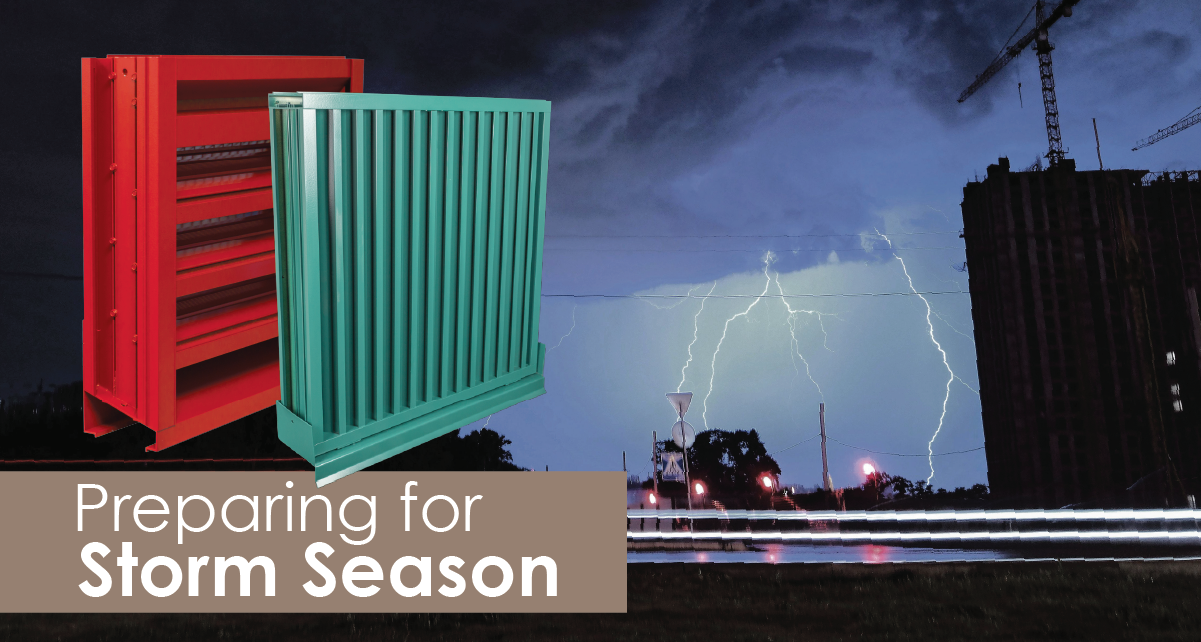Prepare your project for storm season with louvers built for protection. In this article, we cover five types of louvers designed and tested for severe weather.
Preparing for Storm Season
Summer rain can be a nice break from the heat, but light rain can quickly develop into a severe weather event. You need to account for the worst weather conditions when planning out a building project. Protect interior spaces and ventilation points with louvers built for storm season.

There are several distinct types of louvers available. Every louver is designed to protect an opening from harmful elements, while allowing air to pass through. However, there are key differences in design and testing that separate one louver type from another.
Design is important, but testing is the key indicator. A louver may have all the traits of a severe weather louver, but it cannot meet a severe weather requirement without the proper testing. Manufacturers will always post the tests completed and any relevant data from the tests, along with any certified seals or labels, on the louver's submittal document. Always check the submittal for this information before selecting for a specific requirement.
In this article, we will discuss louver types designed for storm protection.
For more, check out our other Newsstand articles on louvers:
- Three Common Types of Intake Louvers
- The Condenser - Louver Style for Building Aesthetics
- Combination Stationary - Two-in-One Louver Solutions
Drainable Louvers

Used for: Light rain and mild weather.
Tests: AMCA Water Penetration Tests
This louver type overlaps with the other types on this list. All storm-ready louvers are drainable louvers. For this article, we will assume that "drainable louvers" are louvers that have drainable features but haven’t received the tests necessary to be used in other scenarios.
Drainable louvers are still an important addition to your building. They provide a basic level of protection that keeps interior spaces dry. Their drainable features capture water and quickly drain it out of the louver. The captured water will move from channels in the jambs to the louver’s sloped sill and out of the louver’s face.

Most drainable louvers will undergo water penetration testing, in accordance with AMCA Standard 500-L. These tests subject the louver to rainfall across the louver’s face, then measure the speed of airflow through the louver during intake. The test ends when 2.5 ounces of water infiltrate the louver, or when the speed of airflow exceeds 1250 feet per minute. This measurement becomes the louver’s beginning point of water penetration.
This data will be available on the louver’s submittal, typically displayed as a graph. You can use this graph to help determine whether the louver will work for your building. Check that your expected intake speed will not exceed the louver’s beginning point of water penetration. Drainable louvers that complete this test will receive an AMCA certified rating seal on their submittal for water penetration.
Wind Driven Rain Louvers

Used for: Heavy rain, high winds, and severe weather.
Tests: AMCA Wind Driven Rain Tests
As their name implies, wind driven rain louvers protect against rain driven by gusts of wind. These louvers will have additional blade features, known as catches, which capture water as it passes over the louver’s blades. Water caught in these catches will slide towards drain channels in the jambs as air passes across the blade. The louver’s drain channels will direct the water out through the louver’s face.
Wind driven rain louvers will reject substantial amounts of water, to the point where captured water may flood the louver’s sill. In these instances, you can choose to add an optional drain pan to protect the interior space from splash back. Wind driven rain louvers are typically used in regions where severe weather is common, but they can be installed anywhere a louver is required. You never know when to expect severe weather. It’s important to keep your project prepared for the worst.

Wind driven rain louvers undergo a more rigorous test: the louver is subjected to a gust of wind blowing through a chamber of water sprayers, also while intaking air. This test setup is designed to simulate gusts of wind blowing heavy rain into the louver. For more details on this test, check out our Newsstand article on AMCA’s wind driven rain testing.
Testers will measure the amount of water infiltration at several points during the test and assign an effectiveness rating based on the percentage of the total water rejected. The best class, Effectiveness Rating Class A, requires the louver to reject over 99% of all rainfall. Check the louver’s submittal for wind driven rain data and for the AMCA certified rating seal for wind driven rain.
Hurricane Louvers

Used for: Heavy rain, hurricane-force winds, windborne debris.
Test: AMCA 540 and 550, Miami-Dade TAS
Hurricane louvers are built and tested for hurricanes. These louvers will have drainable features and blade catches, like wind driven rain louvers, but they are designed for the worst weather conditions. Hurricane louvers must be able to reject heavy rainfall driven by high velocity winds. They must also withstand impacts from windborne debris. This is why hurricane louver components are typically welded together, instead of fastened, so that the louver maintains structural integrity during a hurricane.
Drain pans are a standard feature of hurricane louvers and will be required when installing the louver. At MCDLG, we provide drain pans with every hurricane louver. Hurricane louvers are commonly installed in projects located near hurricane prone regions. Many coastal regions will require hurricane louvers installed at specific points in your building’s envelope, to protect the interior from damage. Be sure to check local codes and requirements before choosing louvers.
.webp?width=810&height=450&name=Hubspot%20Blogs%20-%20AMCA%20540%20-%20wind%20debris%20(Resize).webp)
Hurricane louvers are tested in accordance with AMCA Standard 540 and AMCA Standard 550. These two test standards determine a louver’s ability to withstand windborne missiles (AMCA 540) and its ability to reject high velocity wind driven rain (AMCA 550). Hurricane louvers can also be tested under Miami-Dade standards, but most projects now refer to AMCA’s hurricane louver standards.
To learn more about these tests, read “AMCA 540 and 550” on the Newsstand. AMCA 540 and 550 are geared to simulate hurricane conditions. These louvers must be ready to withstand the worst.
Tornado (FEMA) Louvers

Used for: Storm shelters, windborne debris.
Tests: FEMA 361
Tornado louvers, also known as FEMA louvers, are built for durability first. Like hurricane louvers, the components of FEMA louvers are welded together. They are built from sturdier materials, like structural aluminum. These louvers are commonly installed in storm shelters and tornado safe rooms, to protect ventilation points that lead into these structures. FEMA louvers are heavier than other louver types and will require additional support.
FEMA louvers are tested for resilience. FEMA 361 is a testing standard for impact resistance and for enduring pressure differentials. These louvers can be tested for other weather scenarios, but the louver must meet FEMA’s test standards first.
These louvers must withstand intense air pressure generated by tornados and other severe weather scenarios. And, more importantly, they must remain intact when struck by windborne debris. Only a FEMA louver can meet these requirements.
Sand Louvers

Used for: Sandstorms, areas with sand and dust.
Tests: AMCA Wind Driven Sand
Sand louvers have unique, overlapping vertical blades designed to block sand and other small particles from entering the louver. As air passes through the louver, the heavier particles will be trapped in the pockets created by the blade profiles. The sand then falls to the sill of the louver and is expelled through the face of the louver.
Sand louvers are used in areas where sand infiltration will be a concern, including buildings in desert climates and buildings near beaches. They can double as sight proof louvers, thanks to their overlapping blade design, but their main purpose is preventing sand infiltration.
Sand louvers are tested for wind driven sand penetration in accordance with AMCA Standard 500-L. During the test, calibrated sand particles are introduced to an airstream directed at the louver’s face. Testers will measure the amount of sand rejected by the louver and plot this data on a graph. Once the test is complete, the louver will display this data and an AMCA certified ratings seal for wind driven sand on its submittal. Be sure to check the louver’s submittal for details.

Wherever you decide to build, you will have to deal with bad weather at some point in the year. Choose louvers that will protect your project, and the people who inhabit it. Be prepared for storm season.
Have you prepared your project for severe weather? Tell us how it went in the Comments section below. We want to hear from you!
Preparing for storm season? Consider adding severe weather louvers from Arrow United Industries. We offer louvers for meeting Miami-Dade and other severe weather requirements. Contact us today and let's work together on your next project.

.webp?width=91&height=70&name=MCDLG%20Logo%20(Resize).webp)





